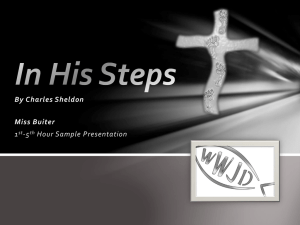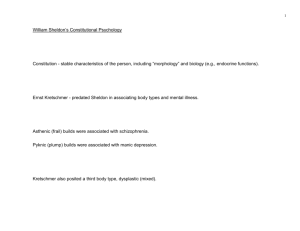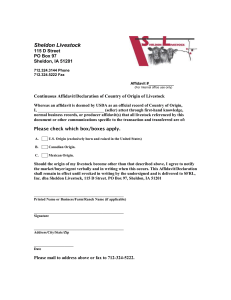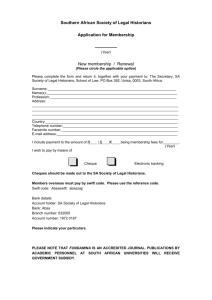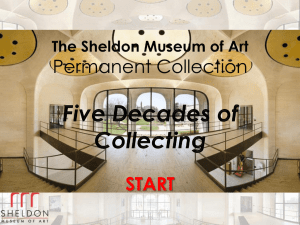STUDY_OF_HISTORY_2 - Mr. Grande`s World History
advertisement
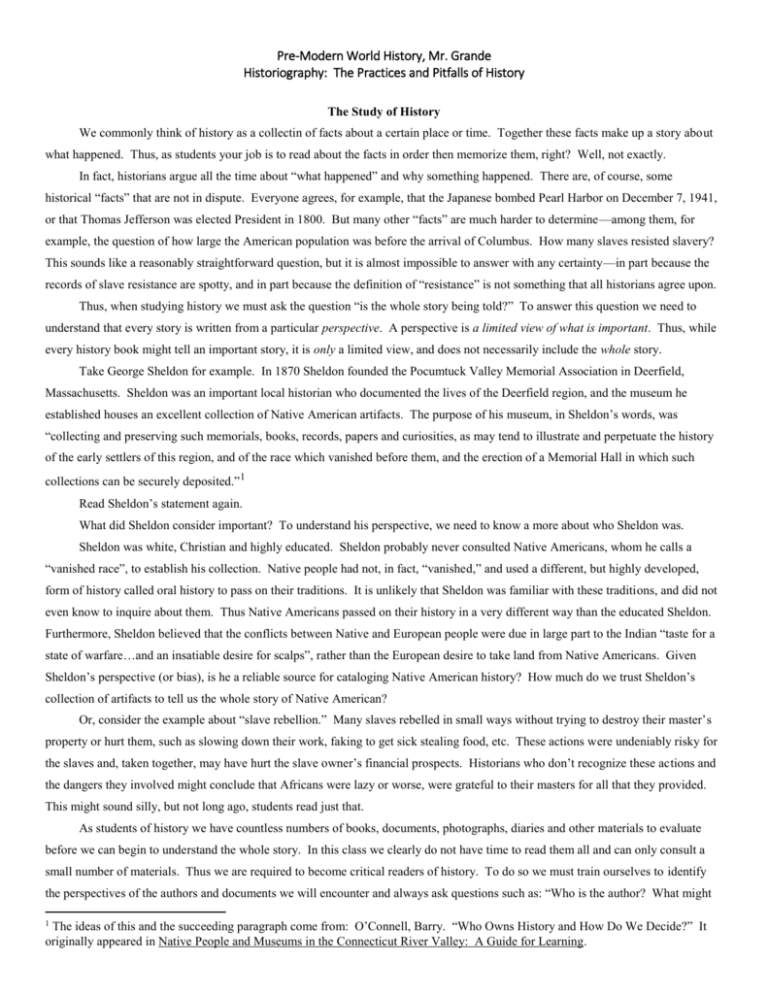
Pre-Modern World History, Mr. Grande Historiography: The Practices and Pitfalls of History The Study of History We commonly think of history as a collectin of facts about a certain place or time. Together these facts make up a story about what happened. Thus, as students your job is to read about the facts in order then memorize them, right? Well, not exactly. In fact, historians argue all the time about “what happened” and why something happened. There are, of course, some historical “facts” that are not in dispute. Everyone agrees, for example, that the Japanese bombed Pearl Harbor on December 7, 1941, or that Thomas Jefferson was elected President in 1800. But many other “facts” are much harder to determine—among them, for example, the question of how large the American population was before the arrival of Columbus. How many slaves resisted slavery? This sounds like a reasonably straightforward question, but it is almost impossible to answer with any certainty—in part because the records of slave resistance are spotty, and in part because the definition of “resistance” is not something that all historians agree upon. Thus, when studying history we must ask the question “is the whole story being told?” To answer this question we need to understand that every story is written from a particular perspective. A perspective is a limited view of what is important. Thus, while every history book might tell an important story, it is only a limited view, and does not necessarily include the whole story. Take George Sheldon for example. In 1870 Sheldon founded the Pocumtuck Valley Memorial Association in Deerfield, Massachusetts. Sheldon was an important local historian who documented the lives of the Deerfield region, and the museum he established houses an excellent collection of Native American artifacts. The purpose of his museum, in Sheldon’s words, was “collecting and preserving such memorials, books, records, papers and curiosities, as may tend to illustrate and perpetuate the history of the early settlers of this region, and of the race which vanished before them, and the erection of a Memorial Hall in which such collections can be securely deposited.”1 Read Sheldon’s statement again. What did Sheldon consider important? To understand his perspective, we need to know a more about who Sheldon was. Sheldon was white, Christian and highly educated. Sheldon probably never consulted Native Americans, whom he calls a “vanished race”, to establish his collection. Native people had not, in fact, “vanished,” and used a different, but highly developed, form of history called oral history to pass on their traditions. It is unlikely that Sheldon was familiar with these traditions, and did not even know to inquire about them. Thus Native Americans passed on their history in a very different way than the educated Sheldon. Furthermore, Sheldon believed that the conflicts between Native and European people were due in large part to the Indian “taste for a state of warfare…and an insatiable desire for scalps”, rather than the European desire to take land from Native Americans. Given Sheldon’s perspective (or bias), is he a reliable source for cataloging Native American history? How much do we trust Sheldon’s collection of artifacts to tell us the whole story of Native American? Or, consider the example about “slave rebellion.” Many slaves rebelled in small ways without trying to destroy their master’s property or hurt them, such as slowing down their work, faking to get sick stealing food, etc. These actions were undeniably risky for the slaves and, taken together, may have hurt the slave owner’s financial prospects. Historians who don’t recognize these actions and the dangers they involved might conclude that Africans were lazy or worse, were grateful to their masters for all that they provided. This might sound silly, but not long ago, students read just that. As students of history we have countless numbers of books, documents, photographs, diaries and other materials to evaluate before we can begin to understand the whole story. In this class we clearly do not have time to read them all and can only consult a small number of materials. Thus we are required to become critical readers of history. To do so we must train ourselves to identify the perspectives of the authors and documents we will encounter and always ask questions such as: “Who is the author? What might The ideas of this and the succeeding paragraph come from: O’Connell, Barry. “Who Owns History and How Do We Decide?” It originally appeared in Native People and Museums in the Connecticut River Valley: A Guide for Learning. 1 an author have left out? Whose view of the story is being considered? Does the author make an effort to represent the views of different racial groups, ethnic groups, poor and rich people, men and women, soldiers and generals, workers and bosses?” We need not then ignore Sheldon’s work. Rather the important thing is to understand his limitations, learn what we can from his work, and look at other sources of history before making any conclusions about the past. This is true of any historical source we look at. Furthermore we need to analyze our own biases. Ask yourself, “What would I need to learn about in order to understand the story of World War I?” Answer the question before reading further. If your answer was, “I need to understand the important battles and the leaders of the armies,” why didn’t you include the stories of others? Did your answer include the workers in the factories who made the weapons? How about the daily lives of women nurses behind the lines? What about the people who protested the war? Are the lives of workers, nurses and protesters any less important than the generals and politicians who planned the war? What effect did protesters, nurses and factory workers have upon the politicians and the course of the war? If your answer was, “I need to understand the important battles and the leaders of the armies,” why didn’t you include the stories of others? Perhaps the full story of World War I must include these stories too. It takes a long time and a lot of work to write the whole story of an event which is why historians stilly study and write about World War I, the Civil War, the American Revolution and even the colonial era. In fact historians continually take old stories and update them. Most students of history are surprised by this: you might ask, “how can history change?” Consider this: sometimes the farther we are from something the broader our perspective is. For example, if you want to learn about trees, do you stand close to one and observe it? Or do you learn more from stepping back and viewing the whole forest at once, evaluating how trees grow and spread their branches among other trees? We can learn a lot about an event from people who wrote about it at the time it took place. However as we move further away in time from the American Revolution, slavery, World War II and countless other events, we have more time to examine evidence that describes those events. No historian has time to read every diary and every newspaper from a particular era, but over time historians can consider more and more evidence as they discover it. In every generation the stories of our past are rewritten by new authors with new ideas about the past. Like any good essay, good history requires revision and the need to ask more questions about the same events over and over again, and to consider more and more perspectives. Thus an event often becomes clearer to us as time passes. For example, after the Civil Rights Movement of the 1950s and 1960s, many historians began to look differently at African Americans, believing that they were willing to risk their lives to gain freedom. Only then did historians begin to look differently at the experiences of slave rebellion, recognizing the bravery of small acts of resistance. This led historians to further reconsider what they write, taking into account workers, not just factory owners and entrepreneurs; women, not just men; ordinary soldiers, not just generals; and so on. Thus our values, biases and what we believe is important changes from generation to generation—and this effects how history books are written. The idea that the ‘story of history’ changes is called “historiography.” Like any history book the textbook for this course doesn’t include everything important about history—don’t be fooled, we need to look at many sources before we can tell the whole story. Just as history books in the past were biased against certain groups or ideas, the same holds true today. You will need to read critically and ask yourselves the questions we looked at in this essay: Is the whole story being told? What is the author’s own perspective and biases? What has the author left out? Moreover, what biases do you hold? How does your own perspective affect your view of history and the present?
